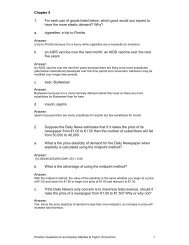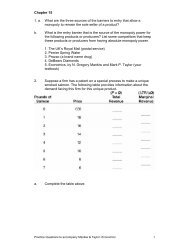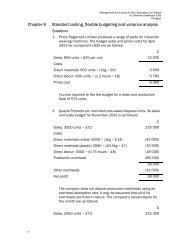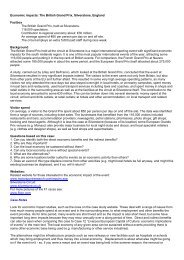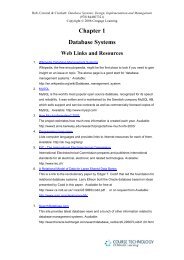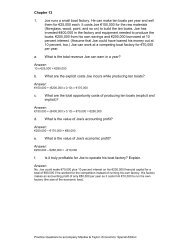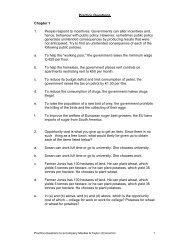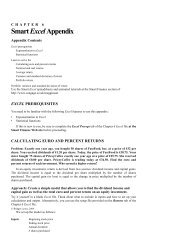Fill out columns three and four of the table above
Fill out columns three and four of the table above
Fill out columns three and four of the table above
You also want an ePaper? Increase the reach of your titles
YUMPU automatically turns print PDFs into web optimized ePapers that Google loves.
. Suppose that <strong>the</strong> competitive wage for workers who can make c<strong>of</strong>feemugs is €19 per hour. How many workers should this firm hire? Why?Answer:Three workers because <strong>the</strong> value <strong>of</strong> <strong>the</strong> marginal product <strong>of</strong> each <strong>of</strong> <strong>the</strong> first <strong>three</strong> workersexceeds <strong>the</strong> €19 wage so each worker adds to pr<strong>of</strong>its but <strong>the</strong> <strong>four</strong>th worker only has a value<strong>of</strong> marginal product <strong>of</strong> €18 so hiring <strong>the</strong> <strong>four</strong>th worker would reduce pr<strong>of</strong>its.c. Suppose that colleges that teach pottery skills increase <strong>the</strong> supply <strong>of</strong>workers that can make c<strong>of</strong>fee mugs <strong>and</strong> that this lowers <strong>the</strong>competitive wage for c<strong>of</strong>fee mug workers to €13 per hour. How manyworkers should this firm hire? Why? Does this represent a shift in <strong>the</strong>firm's dem<strong>and</strong> for labour or a movement along <strong>the</strong> firm's dem<strong>and</strong> forlabour? Explain.Answer:Five workers because <strong>the</strong> value <strong>of</strong> <strong>the</strong> marginal product <strong>of</strong> each <strong>of</strong> <strong>the</strong> first five workers nowexceeds <strong>the</strong> €13 wage but <strong>the</strong> sixth worker only has a value <strong>of</strong> marginal product <strong>of</strong> €12 sohiring <strong>the</strong> sixth worker would reduce pr<strong>of</strong>its. This is a movement along <strong>the</strong> firm’s dem<strong>and</strong>curve for labour because <strong>the</strong> value <strong>of</strong> <strong>the</strong> marginal product <strong>of</strong> labour for each worker isremaining <strong>the</strong> same but <strong>the</strong> wage facing <strong>the</strong> firm has changed.d. Suppose <strong>the</strong>re is an increase in <strong>the</strong> dem<strong>and</strong> for c<strong>of</strong>fee mugs <strong>and</strong> that<strong>the</strong> price <strong>of</strong> c<strong>of</strong>fee mugs rises to €5 per mug. <strong>Fill</strong> <strong>out</strong> <strong>the</strong> last column <strong>of</strong><strong>the</strong> <strong>table</strong> <strong>above</strong> to show <strong>the</strong> value <strong>of</strong> <strong>the</strong> marginal product <strong>of</strong> labourwhen <strong>the</strong> price <strong>of</strong> mugs is €5 per mug.Answer:See <strong>the</strong> fifth column in <strong>the</strong> <strong>table</strong>.Practice Questions to accompany Mankiw & Taylor: Economics 2




